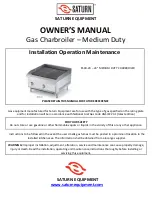
24
damage, and must be replaced with
new ones before the end of their useful
life or before their reliability to meet their
nominal parameters (as stated by their
manufacturers) is diminished.
Properties of heating system and
filling the heating system
It is necessary to set the temperature of
the emergency thermostat according to
the type of implementation of the heating
system (open or closed). For open systems
the emergency temperature is set to 95°C,
for closed systems 105°C.
Setting of the heating water expansion
vessel (pressure in its gas equalizing
section) begins before fi
lling – it is
necessary to add extra pressure (e.g. by 50
kPa (0.5 bar) above the expected resulting
water pressure in the system. This ensures
that the equalizing volume is as large as
possible and that this will be used as such
in further operation. The system is then
fi lled and preliminary pressured by cold
water to the required pressure according
to the pressure gauge on the boiler – in
this manner the remaining (water) part of
the expansion vessel is fi lled and fi lling
is closed. In this state the overpressure
is gradually relaxed from the equalizing
part; the pressure in this is monitored by
a pneumometer. Relaxing of the pressure
continues as long as the equalizing part
is “harder” than the water part (pressure
on the pneumometer is higher than on the
pressure gauge on the boiler).
Only when both monitored values become
very close, very carefully continue
relaxing the equalizing part so that the
both values become equal and both begin
to drop – this is the watershed where the
sought largest equalizing volume is set
for the given working point. In this phase
of setting the expansion vessel changes
in pressure are imperceptible and it is
necessary to proceed very carefully,
since the water is practically impossible
to pressurise, and even in the case of
reduction of the pressure effect its volume
will be practically unchanged. So when
“throw” takes place during relaxation of
the pressure from the equalizing gas part
and the pressure watershed of the sought
working point is exceeded and the water
volume in the system is not changed, the
gas part can be simply re-pressurised
and pressure relaxation in seeking the
pressure watershed can be repeated
more carefully.
The tightness of the valve of the expansion
vessel is not absolutely constant; if the
pressure in the system drops this may be
caused not only by a water leakage, but
also by a reduction of the pressure effect
of the equalizing gas part of the expansion
vessel on the water part – upon topping
up the system pressure by inlet of water
the gas part may then “shrink” in volume,
which reduces the overall expansion
capability of the expansion vessel as
against its nominal state. For this reason
it is never possible to resolve setting
of the expansion vessel only by simple
pressurising of the equalizing gas part
in operation with a longer duration with
absolute certainty (or even in the shortest
operation if water has been charged into
the system)!!!
Setting of the hot water expansion vessel
resides only in its pressurising before fi lling
utility water into the boiler and distribution
system to the resulting working pressure.
After fi lling the heating system, de-aeration
and setting the pressure expansion vessel
(if this is used), the resulting pressure of
the heating water in the system when cold
is indicated by the (red) adjustable hand
of the boiler pressure gauge.








































